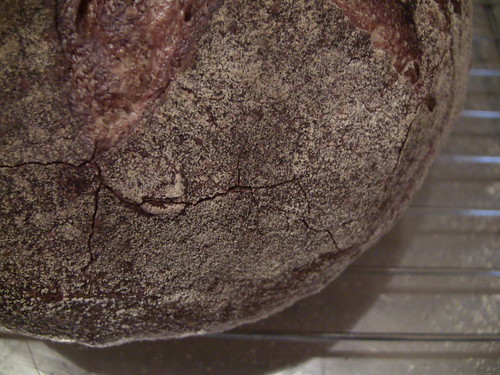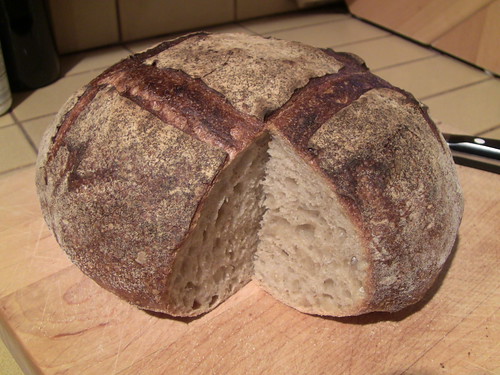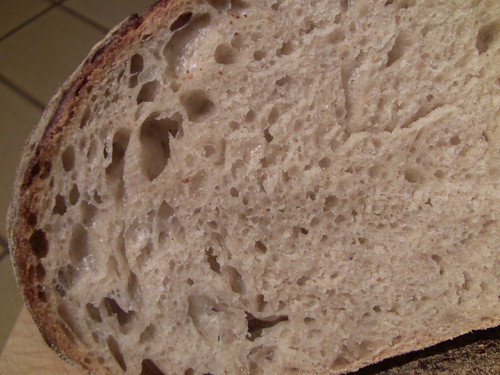
Shall We Call It San Francisco Country Sourdough ?
Or maybe World Series Sourdough?!! [Go, Giants!!]
I have enjoyed Acme Bread’s Pain de Campagne a couple times recently. It’s a moderately sour boule with a thin toothsome crust and a somewhat fluffy, but chewy crumb. I think it has some whole rye flour and some whole wheat flour. It's about my favorite bread ever.
So, today I tried to bake something like it. I used the formula and procedure for Hamelman’s Vermont Sourdough as a starting point, but used KA European Style flour and some KA whole wheat flour and used a longer bulk ferment.
I studied dmsnyder’s boule-shaping tutorial and did my best to follow his tutelage and was very pleased with my shaping effort. I got good oven spring and a nice crust crackles. The crumb is just what I was going for--light but chewy. And the flavor is also pretty close to the Acme Pain de Campagne—nutty and complex and just a little sour. I think this is the best tasting Sourdough I’ve made.
Here’s the formula:
San Francisco Country Sourdough
Yield: Two 1.5 lb Loaves
Ingredients
LIQUID-LEVAIN BUILD
100 grams AP flour
24 grams Whole Wheat flour
12 grams Whole rye flour
170 grams Water, luke warm
28 grams Mature culture (75% hydration)
FINAL DOUGH (66% hydration, including levain)
680 grams KAF European-Style Artisan Bread flour (88%)
45 grams Whole wheat flour (6%)
45 grams Whole rye flour (6%)
425 grams Water at room temperature (55%)
17 grams Salt (2%)
306 Liquid levain (40%)
Directions
1. LIQUID LEVAIN: Make the final build 12 to 16 hours before the final mix, and let stand in a covered container at room temperature (about 70 F).
2. MIXING: Add all the ingredients to the mixing bowl, including the levain, but not the salt. Mix just until the ingredients are incorporated into a shaggy mass. Correct the hydration as necessary. Cover the bowl with plastic and let autolyse for 30 to 60 minutes. At the end of the autolyse, sprinkle the salt over the surface of the dough, and finish mixing 5-7 minutes.
3. BULK FERMENTATION WITH S&F: 3 hours. Stretch and fold the dough in the bowl twice 30-strokes at 45-minute intervals. Place dough ball in lightly oiled bowl, and stretch and fold on lightly floured board at 45 minutes.
4. RETARDED BULK FERMENTATION (optional): After second s&F on board, form dough into ball and then place again in lightly oiled bowl. Refrigerate 8-20 hours, depending on sourness desired and scheduling convenience. [I skipped this step this time].
5. DIVIDING AND SHAPING: Divide the dough into two pieces and pre-shape. Let sit on board for 30 minutes, and then shape into boules or batards.
6. PROOFING: Approximately 2 to 2 1/2 hours at room temperature (about 70° F). Ready when poke test dictates. Pre-heat oven to 500 F with steam apparatus in place.
7. BAKING: With steam, on stone. Turn oven to 460 °F after steaming. Remove steaming apparatus after 12 minutes. Bake for 35 to 40 minutes to
tal. Rotate loaves for evenness as necessary. When done (205 F internal temp), leave loaves on stone with oven door ajar 10 minutes.
I recommend this bread to anyone who likes sourdough with a moderate amount of whole grain.
Glenn






Comments
Well done Glenn! Great looking boules and crumb!
Hi,Glenn
Your boules look fantastic! Nice scoring!! You must get the right timing to put them in the oven. I always bake my sourdough earleir than that supposed to be..so that my scoring job seems to explode. I will wait further to get the great result like yours next time. Thank you for sharing !!!
I really like your boules that are rustic looking. That is very cool!
Akiko
That is some bold crust!
I like it!
Lovely crust and crumb. And it sounds like you hit your taste target. Congratulations!
Go Sourdough!
David
The boule-shaping owes a lot to your tutorial (though you didn't tell me I wasn't supposed to put the toothpicks in the oven!).
I wonder how much the great crust has to do with the KAF European-Style Artisan Flour. I'll try this formula with KAF AP some time to compare.
Glenn
I would have to vote you the number one most progressed in the shortest time phase baker on TFL! Great job, Glenn!
Sylvia
Thanks, Sylvia. That's a really nice thing to say. I feel like I'm just learning the basics. Every experiment leads to ideas for new ones. I bet this dough would be good for baguettes. But I wanted to try the Bouabsa formula with a lower hydration. And I was going to try an all-white sourdough baguette. And the SJSD baguettes were good, and I was going to try that formula with a little higher hydration. And then I found the blog about the Gosselin-Bouabsa Hybrid. Yikes!
Glenn
Beautiful, Glenn. Would you mind if I feature it for a bit?
-Floyd
You did an excellent bake on those boules Glenn. Good shaping as well ! Pain de Campagne is one of my all time favourites and this is a great recipe, well executed. Nice job!
Franko
Thanks, Franko. There's something about the flavor of nutty whole wheat with a little sourness that just works for me.
Glenn
I appreciate your comments. The bread tastes even better today.
Floyd, my bread would be honored. Thanks.
Glenn
Beautiful work Glenn! You seem to becoming a baker.
Larry
Thanks, Wally. I have a lot to learn, but I get to eat my homework.
Glenn
Looks like you got everything right.
Congrats to you!
Sue
BTW, you have a TFL message about it. ;-)
Ron
What beautiful bread...inside & out. Since it tastes as good as it looks you have a home run!
I recently took some SJSD I made from David's recipe with us to Vegas and was pleasantly surprized to find it tasted better each day. I am a sourdough junkie for sure!
Good job & you had fun...a very important ingredient.
Toni
It was a very satisfying bake all around.
I agree the taste of SJSD improves the second day. And it makes great toast!
Glenn
Looks great, excellent crust. Bet it has an awsome "chew".
Can you explain "Stretch and fold the dough in the bowl twice 30-strokes at 45-minute intervals"...maybe I have missed somthing in my summer baking hiatus. Stroke and stretch just seem an odd decriptive combination.
Thanks
Here's my description of the "stretch and fold in the bowl" method:
It is best for slack doughs. Most use a flexible plastic scraper, but I have found a rubber spatula to work as well. Remember, we are talking about very sticky doughs. Believe me: getting the dough to stick to the spatula or scraper is not a problem. Getting it unstuck? Well that's another matter.
So, your dough is in a bowl that is large, say 3 times the dough's volume. You insert your scraper between the dough and the bowl at 12 o'clock (assuming you are at 6 o'clock) and stretch the dough your scraper contacts up and over the ball of dough and press it into the dough. If you do this fast, the dough will release the scraper. Maybe some will stick to it.
Turn the bowl 1/5 turn. (I am right-handed and rotate the bowl clockwise.) Insert your scraper between the new portion of dough now at 12 o'clock and do as described above again. Repeat this turn, insert, stretch, press, release maneuver 20-30 times.
Cover the bowl and set a timer for when you want to repeat this procedure. Generally, this would be between 20 and 60 minutes.
How many times you repeat it depends on the degree of gluten development you want.
I have been doing 3 sets of stretch-and-folds 20 minutes apart for a dough with 75% hydration.
Note: Mark Sinclair has made a great video of this technique: no-knead video
I hope this clarifies the technique for you.
David
I was hoping you'd say that.
Diffr'nt strokes...
Glenn
Your recipe says 66% hydration not 75%?
Can you do no knead stretch and fold with 66% hydration?
What is the advantage of the liquid levain method vs. the Peter Reinhardt method?
Home Mill--
The total hydration of the dough is 66%. The levain is 75%.
Stretch and fold works fine with 66% hydration dough.
As to the advantages of levains of different hydrations, there has been much discussion on that. I suggest you use the search function on the left side of the TFL page to do some research.
Glenn
After last my baking disaster last weekend I now have a serious desire to get my starter back on track and turn out some bread like yours. I did follow your directions to the letter, but my starter was just too weak to do what it needed to do to work.
Hi, do I have to convert my 100% hydration starter to 75% (how do I do that?) or can I adjust my hydration levels in the liquid levain build stage? Thanks
Take 1x your 100% starter and add 3x water and 4x flour to get an approximately 75% final levain. Or use your 100% starter and adjust the water in the final dough. Either should work.
Let us know how it comes out.
Glenn
was an interesting exercise and one that I learned a lot from. I probably went the long way round, but achieved 28 gram at 75% by a convoluted mathematical equation that only I could work out. haha. Your reply came a little late for my impatience, and when I saw the easy way you did it I laughed. I feel confident that I could adjust any recipe now, so thanks. I've posted a photo (on my blog) of one loaf which turned out beautifully. The first one, although a little burned on the outside, tastes quite yummy. I am not at all used to sourdough as it's just a relatively new thing over here in Australia, at least it is just starting to appear in the bakeries where I live now. (It's not very nice though; I'd say it's a very commercial version and in name only). My starter which I started from scratch, I suspect is still fairly immature, but getting better all the time. It's only about 6 weeks old, but I am surprised at the flavour in this loaf today. I think I actually tasted the sour in sourdough for the first time! So nice! And if it only gets better from here on in.... well I'm lost.... So thanks for posting such a detailed recipe and instructions. I don't have any bread books yet. I've ordered three from the US and am waiting patiently for them.
Is there actually enough used to be concerned about such a small amount of liquid? It's only 28 grams, you're talking about a correction of a couple tablespoons during mixing.
Is my liquid levain supposed to grow in size or just get nice and frothy? Don't worry about answering this as I've found the answer to this here on TFL.
Seems to me that mine is always kind of a very thin sponge or a thick froth.. it seems on the verge of wanting to be a cohisive mass, but it just ain't happening, if you know what I mean.
Geeze, I've made this bread a couple times now... have to say, definitely take the time and do the retarded ferment, the difference in flavor is incredible. This is a terrific bread, flavor, texture, looks... all the way around. Thanks for sharing this, for sure. I also add vital wheat gluten to this at a rate of about 3% of the total weight of all the flours used, including the levain--which comes out to around 20-24 grams for this recipe. You could probably go a little higher if you want becaue of the whole grains, don't think I'd go above 4%. I've been using KA bread flour, 365 (Whole Foods house brand) whole wheat, and Bob's Red Mill dark rye, with VWG from Arrohead Mills, with a SF sourdough strain I bought from International Sourdough several years ago. I've also been doing a half batch of this, just one loaf. Two is just way too much around here!
Glad you like the formula. It's just my variation on Hamelman's Vermont Sourdough, so I can't take much credit. I've never tried it with "bread flour" or added gluten. Post some pictures of your bake if you can. I'm curious.
Glenn
Yes! I like this bread the way it looks. But I has a quetion, how to make it crack like what I see it in the 3rd picture.
Thank you, :)
Laddavan
Laddavan--
There's been much discussion on this topic. Here's one thread (http://www.thefreshloaf.com/node/18026/consistent-crackly-crust-conundrum-conquered.
Glenn